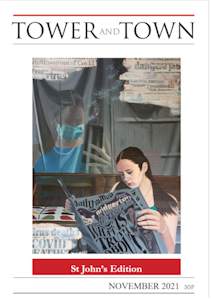

Tower and Town, November 2021 (view the full edition) (view the full edition)Morgan's Hill
On a bright, crisp day in November a chalky track besides Wiltshire Wildlife Trust's Nature Reserve at Morgan's Hill rises up to inspiring views of Cherhill Down and the plains of north Wiltshire. A Roman road runs along its northern edge and the fifth century Wansdyke, built to defend the northern territory of Wessex, defines its southern border. You may look across to a string of cattle or a flock of Herdwick sheep, while above in a patch of blue sky a kite and a "cronking" raven are having a spat. The grazing animals are helping to control the grassland levels, but the Trust, in conjunction with the local farmer, have to manage this carefully, to avoid overgrazing. From time to time scrub clearance is required, and areas of invasive tor-grass need controlling, scraping back to the bare chalk so that different plants and invertebrates can colonise. The reserve is a Site of Special Scientific Interest for its orchids, butterflies and for the general quality of its chalk grassland and wildflowers. Unusually all three of the UK's native conifer trees grow here - Scots pine, juniper and yew - possibly planted as drovers' waymarkers. There are cowslips, primroses and violets in spring, and wild thyme, horseshoe vetch, rock rose, round-headed rampion, marsh helleborine and autumn gentian as the season progresses. Eleven species of orchid occur, including early purple, spotted, fragrant, twayblade, bee and pyramidal. Where there are flowers, butterflies follow. Along the Wansdyke you can find the adonis, chalkhill and common blues and further down the slopes you may spot the marsh fritillary - one of the UK's endangered species, the larvae of which feed on devil's-bit scabious. Rarer still is the similar-looking metalmark the Duke of Burgundy, a favourite with butterfly lovers. Birds found at the reserve include red kite, kestrel, buzzard, yellowhammer and skylark. There are migrants too: I disturbed a ring ouzel from a hawthorn bush in early spring, and wheatears like the short turf on the adjacent golf course. It is believed the hill was named after a local man, John Morgan, who in 1720 was hanged at this site for murdering his uncle. On a more pleasant note, as you leave the reserve, you may notice a stone with a memorial on it to Beatrice Gillam (1920-2016), revered local naturalist and one of the founders of the Wiltshire Wildlife Trust (www.wiltshirewildlife.org ). Robin Nelson |